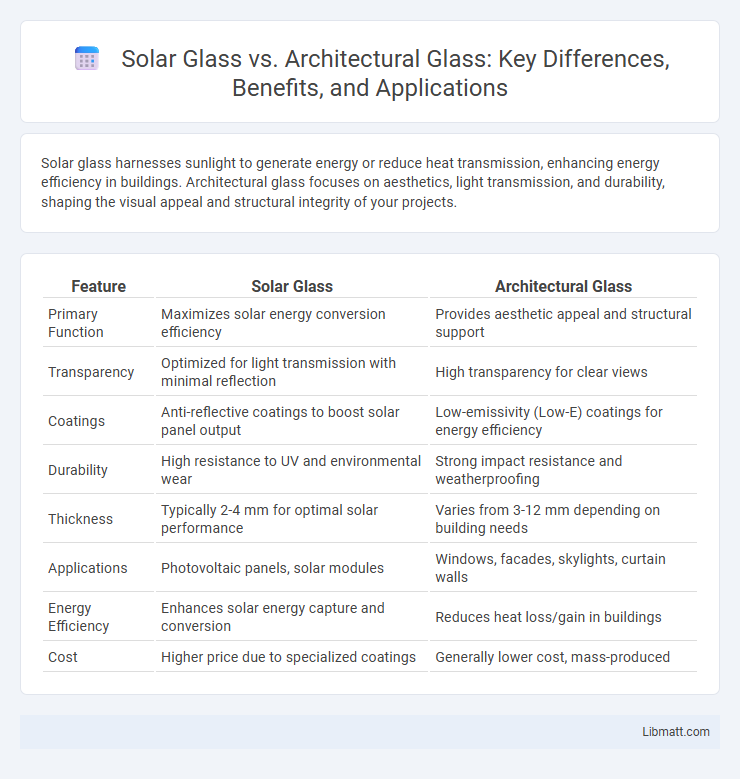Solar glass harnesses sunlight to generate energy or reduce heat transmission, enhancing energy efficiency in buildings. Architectural glass focuses on aesthetics, light transmission, and durability, shaping the visual appeal and structural integrity of your projects.
Table of Comparison
| Feature | Solar Glass | Architectural Glass |
|---|---|---|
| Primary Function | Maximizes solar energy conversion efficiency | Provides aesthetic appeal and structural support |
| Transparency | Optimized for light transmission with minimal reflection | High transparency for clear views |
| Coatings | Anti-reflective coatings to boost solar panel output | Low-emissivity (Low-E) coatings for energy efficiency |
| Durability | High resistance to UV and environmental wear | Strong impact resistance and weatherproofing |
| Thickness | Typically 2-4 mm for optimal solar performance | Varies from 3-12 mm depending on building needs |
| Applications | Photovoltaic panels, solar modules | Windows, facades, skylights, curtain walls |
| Energy Efficiency | Enhances solar energy capture and conversion | Reduces heat loss/gain in buildings |
| Cost | Higher price due to specialized coatings | Generally lower cost, mass-produced |
Introduction to Solar Glass and Architectural Glass
Solar glass is designed to enhance energy efficiency by integrating photovoltaic cells or applying specialized coatings that regulate solar heat and light transmission. Architectural glass primarily focuses on structural integrity, aesthetic appeal, and natural light utilization in building designs. Understanding the differences between these types ensures you optimize energy savings and design performance in your construction projects.
Key Differences Between Solar Glass and Architectural Glass
Solar glass is specifically designed to enhance energy efficiency by integrating photovoltaic cells or coatings that convert sunlight into electricity, whereas architectural glass primarily focuses on aesthetics, natural light transmission, and thermal insulation. Solar glass often incorporates features such as low-emissivity coatings and durability to withstand environmental exposure, while architectural glass prioritizes factors like clarity, color, and safety standards for building facades and interiors. Your choice between the two depends on whether energy generation or visual and structural performance is the primary goal for your building project.
Composition and Material Properties
Solar glass consists of tempered silica with anti-reflective coatings and embedded photovoltaic layers to maximize light absorption and energy conversion, while architectural glass primarily uses soda-lime or borosilicate compositions optimized for clarity, strength, and thermal insulation. The high iron content in architectural glass can cause slight greenish tinting, whereas solar glass is engineered for minimal light loss and maximum durability against weathering. Your choice depends on whether you prioritize energy generation or aesthetic and structural performance in building applications.
Energy Efficiency and Performance
Solar glass significantly enhances energy efficiency by converting sunlight into electricity, reducing your reliance on traditional energy sources and lowering utility costs. Architectural glass primarily focuses on thermal insulation and natural light transmission, optimizing building performance without generating power. Choosing solar glass integrates sustainable energy production with building design, while architectural glass excels in passive energy management.
Applications in Modern Buildings
Solar glass provides energy-efficient solutions by integrating photovoltaic cells to generate electricity while allowing natural light, making it ideal for sustainable facades and skylights in modern buildings. Architectural glass offers versatility with enhanced aesthetics, insulation, and durability, suitable for curtain walls, partitions, and windows that optimize daylight and thermal performance. Your choice depends on balancing energy generation needs with design preferences and building regulations.
Aesthetic Considerations and Design Flexibility
Solar glass offers a sleek, modern aesthetic with the ability to integrate photovoltaic cells seamlessly into building facades, enhancing energy efficiency without compromising design. Architectural glass provides extensive design flexibility with options for various tints, coatings, and textures, allowing customization to match diverse styles and lighting needs. Choosing between them depends on Your priorities for visual appeal combined with sustainable energy solutions or purely aesthetic architectural expression.
Durability and Weather Resistance
Solar glass is engineered with special coatings and tempered layers that enhance its durability and weather resistance, making it highly effective at withstanding harsh environmental conditions such as UV exposure, temperature fluctuations, and moisture. Architectural glass, while durable, often prioritizes aesthetic qualities and may lack the advanced protective features found in solar glass, leading to potential wear over time in extreme weather. Your choice between these glass types should consider the specific environmental demands and long-term performance requirements for optimal resilience.
Cost Comparison and Long-term Savings
Solar glass typically incurs higher upfront costs than standard architectural glass due to embedded photovoltaic technology and specialized manufacturing processes. Over the long term, solar glass delivers substantial energy savings by generating electricity, reducing reliance on external power sources and lowering utility bills. While architectural glass offers initial affordability and aesthetic versatility, solar glass provides enhanced financial benefits through energy efficiency and potential incentives or rebates.
Environmental Impact and Sustainability
Solar glass significantly reduces environmental impact by enhancing energy efficiency through photovoltaic integration, converting sunlight into renewable energy and lowering carbon emissions. Architectural glass prioritizes sustainability by maximizing natural light, reducing the need for artificial lighting, and incorporating recycled materials during manufacturing. Both types support green building certifications, but solar glass actively generates clean energy, offering a greater contribution to sustainable building practices.
Choosing the Best Glass for Your Project
Solar glass offers superior energy efficiency by integrating photovoltaic cells that convert sunlight into electricity, making it ideal for sustainable buildings seeking reduced energy costs. Architectural glass provides versatile design options with various thicknesses, coatings, and tints to enhance aesthetics, natural light, and thermal insulation in commercial and residential projects. Selecting the best glass depends on project goals, balancing energy performance and design requirements to optimize both functionality and visual appeal.
Solar glass vs architectural glass Infographic

 libmatt.com
libmatt.com